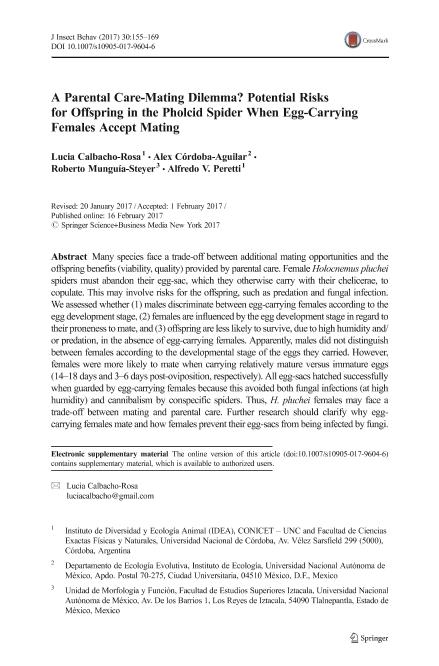Mostrar el registro sencillo del ítem
dc.contributor.author
Calbacho Rosa, Lucía Soledad

dc.contributor.author
Córdoba Aguilar, Alejandro

dc.contributor.author
Munguía Steyer, Roberto
dc.contributor.author
Peretti, Alfredo Vicente

dc.date.available
2018-08-24T15:03:40Z
dc.date.issued
2017-03
dc.identifier.citation
Calbacho Rosa, Lucía Soledad; Córdoba Aguilar, Alejandro; Munguía Steyer, Roberto; Peretti, Alfredo Vicente; A parental care-mating dilemma? Potential risks for offspring in the Pholcid spider when egg-carrying females accept mating; Springer/Plenum Publishers; Journal of Insect Behaviour; 30; 2; 3-2017; 155-169
dc.identifier.issn
0892-7553
dc.identifier.uri
http://hdl.handle.net/11336/56946
dc.description.abstract
Many species face a trade-off between additional mating opportunities and the offspring benefits (viability, quality) provided by parental care. Female Holocnemus pluchei spiders must abandon their egg-sac, which they otherwise carry with their chelicerae, to copulate. This may involve risks for the offspring, such as predation and fungal infection. We assessed whether (1) males discriminate between egg-carrying females according to the egg development stage, (2) females are influenced by the egg development stage in regard to their proneness to mate, and (3) offspring are less likely to survive, due to high humidity and/or predation, in the absence of egg-carrying females. Apparently, males did not distinguish between females according to the developmental stage of the eggs they carried. However, females were more likely to mate when carrying relatively mature versus immature eggs (14–18 days and 3–6 days post-oviposition, respectively). All egg-sacs hatched successfully when guarded by egg-carrying females because this avoided both fungal infections (at high humidity) and cannibalism by conspecific spiders. Thus, H. pluchei females may face a trade-off between mating and parental care. Further research should clarify why egg-carrying females mate and how females prevent their egg-sacs from being infected by fungi.
dc.format
application/pdf
dc.language.iso
eng
dc.publisher
Springer/Plenum Publishers

dc.rights
info:eu-repo/semantics/openAccess
dc.rights.uri
https://creativecommons.org/licenses/by-nc-sa/2.5/ar/
dc.subject
Egg Survival
dc.subject
Egg-Carrying
dc.subject
Holocnemus Pluchei
dc.subject
Maternal Care
dc.subject
Parental Care Benefits
dc.subject
Sexual Selection
dc.subject.classification
Otras Ciencias Biológicas

dc.subject.classification
Ciencias Biológicas

dc.subject.classification
CIENCIAS NATURALES Y EXACTAS

dc.title
A parental care-mating dilemma? Potential risks for offspring in the Pholcid spider when egg-carrying females accept mating
dc.type
info:eu-repo/semantics/article
dc.type
info:ar-repo/semantics/artículo
dc.type
info:eu-repo/semantics/publishedVersion
dc.date.updated
2018-08-17T14:32:07Z
dc.identifier.eissn
1572-8889
dc.journal.volume
30
dc.journal.number
2
dc.journal.pagination
155-169
dc.journal.pais
Estados Unidos

dc.journal.ciudad
New York
dc.description.fil
Fil: Calbacho Rosa, Lucía Soledad. Consejo Nacional de Investigaciones Científicas y Técnicas. Centro Científico Tecnológico Conicet - Córdoba. Instituto de Diversidad y Ecología Animal. Universidad Nacional de Córdoba. Facultad de Ciencias Exactas Físicas y Naturales. Instituto de Diversidad y Ecología Animal; Argentina
dc.description.fil
Fil: Córdoba Aguilar, Alejandro. Universidad Nacional Autónoma de México; México
dc.description.fil
Fil: Munguía Steyer, Roberto. Universidad Nacional Autónoma de México; México
dc.description.fil
Fil: Peretti, Alfredo Vicente. Consejo Nacional de Investigaciones Científicas y Técnicas. Centro Científico Tecnológico Conicet - Córdoba. Instituto de Diversidad y Ecología Animal. Universidad Nacional de Córdoba. Facultad de Ciencias Exactas Físicas y Naturales. Instituto de Diversidad y Ecología Animal; Argentina
dc.journal.title
Journal of Insect Behaviour

dc.relation.alternativeid
info:eu-repo/semantics/altIdentifier/doi/http://dx.doi.org/10.1007/s10905-017-9604-6
dc.relation.alternativeid
info:eu-repo/semantics/altIdentifier/url/https://link.springer.com/article/10.1007%2Fs10905-017-9604-6
Archivos asociados
